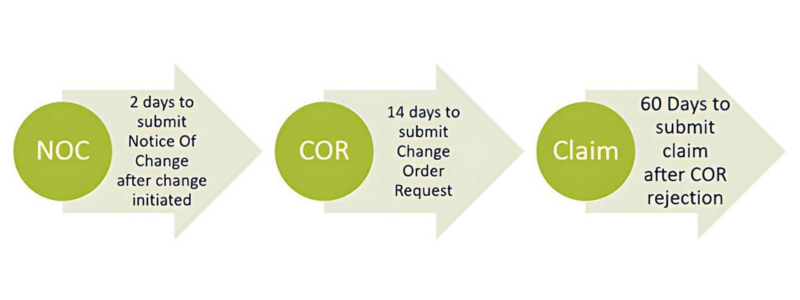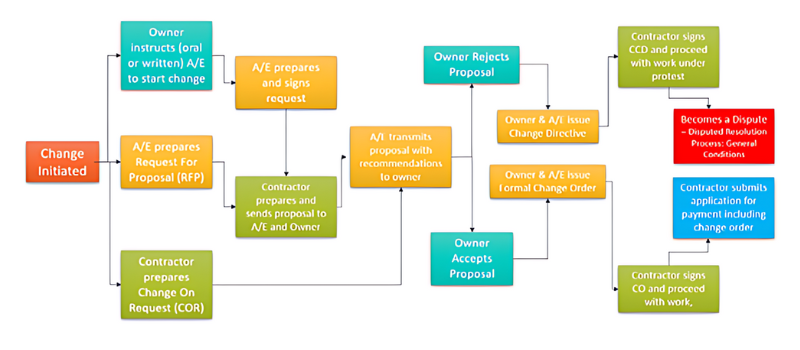Contract modifications are very common in construction projects and most people refer to these modifications as “change orders.” In general, contract modifications are required whenever a change has an impact on the contract documents, regardless of whether the change will affect time or cost. Understanding contract modifications and the impact these changes have on surety claims is vital when it comes to dealing with construction claims and completing a defaulted project.
In this post, we discuss the importance of understanding contract modifications when taking over a contract after a default, specifically:
- Identifying Contract modifications when a claim arises.
- Time constraint for submission of contract modifications
- Negotiating contract modifications before takeover agreement
When a Claim Arises: Understand Changes in Place, Pending Changes and Not-Yet Submitted Changes
After a claim is made against the bond and the surety is acting on the claim, an important step is to examine closely any contract modifications to understand clearly the impact of these modifications on time and price. The following questions should be asked:
- Are there any pending change orders submitted to the owner that have not been paid?
- Are there any change orders that have not yet been submitted to the owner?
- Is the scope of work for pending or not-yet submitted change orders complete?
- Do any of those pending or not-yet submitted change orders affect the contract time?
- Are there any internal change orders from the subcontractors to the contractor that might become a claim against the payment bond?
Being aware of all contract modifications pending or not-yet submitted on the project is important to negotiations with the owner and subcontractors during a takeover. The surety should have a general understanding of the nature of these change orders (are they classified as ones that will affect contact time or price or are they minor changes?) before negotiating with the owner to resolve the claim. The following are some scenarios that might help the negotiations:
- If the work has been completed without proper approval from the owner, having the total amount due for that work before signing a contract between owner/surety is the best practice.
- If the work has not been completed and the change order is still pending for approval, then the surety can negotiate to the extent that the work will not be completed until the contract modification is approved.
- If the defaulted general contractor did not submit the change order to the owner, it is in the surety’s best interest to evaluate and submit the change order accordingly and account for any time extension or increased cost that might be required.
- If an internal change order has been completed by the subcontractor, but not yet approved by the general contractor, the terms should be negotiated with the subcontractor during the ratification process or before final payment if the subcontractor is not returning to work. In some instances Ratification might be ideal when the subcontractor is willing to finish, negotiate and cooperate with the new general contractor but is not always the best option if the subcontractor was not performing well or had issues with the previous general contractor, therefore is not willing to finish, cooperate or negotiate with the new contractor.
Ideally, it will be possible to delineate everything that happened along two time lines: before the principal defaulted and after the default. When the amounts and scope of work are clearly mapped and included in the new agreement, future confusion with the Obligee and subcontractors can be avoided: Contract modifications that were not included during the contract negotiations (ratification) should not be a reason for a claim in the future.
If the surety is completing the project, the new agreement should stipulate which contract modifications will be accepted. For instance, if a contract modification is purely a preference and not needed to comply with one of the reasons below, the surety should make this clear in the contract. The following are some examples of justified modifications in a new contract:
- The intent of the documents is not “reasonably inferable” and corrections are required to eliminate errors, omissions, discrepancies or design deficiencies.
- Unknown conditions necessitate changes to the project.
- There are changes in the regulations after a permit has been issued.
- The period between bid proposal acceptance and contract execution is long.
- There are interpretations of the regulations by Agencies Having Jurisdiction (AHJs)
- A specified product is no longer available or a new product is under consideration because it offers cost savings or other benefits.
- The estimated quantity of work-for-unit price has changed.
- Unattainable requirements exist and need to be revised.
One contract modification that the contractor and/or surety can deny performing is the case of a cardinal change. The cardinal change doctrine is a response to an owner’s ability to make significant changes to a construction project’s scope of work. This doctrine gives contractors the right to walk away from a contract if they feel that an owner is attempting to enact a cardinal change to the scope of the project.
Pay Close Attention to Requirements for Notification and Submission
The surety should be aware of timelines and procedures for submission of contract modifications in every project as defined in each contract. Timeframes and procedures differ by contract, so it is important to pay attention to the specific language regarding notification and submission of change orders in each contract.
- What does the contract require regarding contract modification submissions?
- What length of time is required to notify the owner that a change order will be forthcoming?
- What length of time is required to submit a change order or a claim once notification has been made?

Cost increases or decreases for a change order may be determined based on one or more of the following methods:
- Mutual acceptance of a stipulated sum
- Unit prices as stated in contract documents or subsequently agreed upon
- Contractor costs plus a fixed or percentage fee for overhead and profit
- Construction Change Directive, with costs to be resolved per the terms of the contract
Regardless of the method, the defined process needs to be followed carefully in order to submit a change order and incorporate it into the pay application. There might be minor changes to the process depending on the contract, but in general, the change is initiated by the owner, an architectural engineer or contractor depending on what has happened to initiate the need for the change. In the diagram below, the process steps and roles have mapped with colors for easier understanding.

Before the Project Moves Forward: Best Practices in Negotiating a Takeover Agreement
At the very a minimum, the following should be key points of discussion during the negotiation of a takeover agreement:
- A clearly defined scope of work
- Confirmation and statement of financial status of bonded contract
- Reservation of rights and claims
- Extension of time and delay damages
- Resolution of open change orders and back charges
- Dispute resolution provision
- Timeline for Contract modifications
For more information on contract modifications, please contact Gisel Hernandez at ghernandez@vertexeng.com or submit an inquiry to VERTEX directly.




